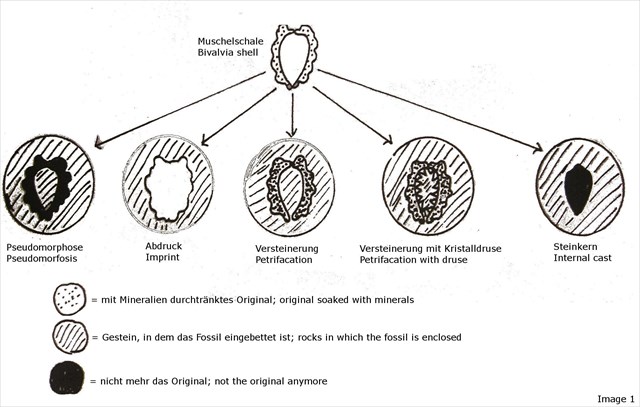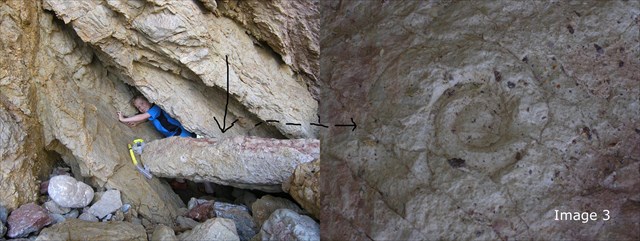THROUGH THE CLIFF: FOSSILISATION (MALLORCA) EarthCache
THROUGH THE CLIFF: FOSSILISATION (MALLORCA)
-
Difficulty:
-

-
Terrain:
-

Size:  (not chosen)
(not chosen)
Please note Use of geocaching.com services is subject to the terms and conditions
in our disclaimer.
Nimm Bild 4 mit!
Take image 4 with you!
Tenga foto 4!
Bei Flut oder Wind ist die Cachelocation nicht zu erreichen!
During high tide or wind this cache is not accessible!
 Auf meinem Weg durch das Kliff habe ich einige Fossilien entdeckt, die ich euch zeigen möchte!
Auf meinem Weg durch das Kliff habe ich einige Fossilien entdeckt, die ich euch zeigen möchte!
 On my way through the cliff I found some fossils that I want to show you.
On my way through the cliff I found some fossils that I want to show you.
 En mi camino a través del acantilado, descubrí algunos fósiles que quiero mostrarte.
En mi camino a través del acantilado, descubrí algunos fósiles que quiero mostrarte.
 Geologie:
Geologie:
Mallorca ist geologisch gesehen der östliche Teil der Betonischen Kordillere, einem Gebirgszug, der von Nordafrika über Südspanien reicht und dann im Mittelmeer versinkt, um als Balearen wieder an die Oberfläche zu kommen. Durch die Einwirkung gewaltiger tektonischer Kräfte wurde das Urmittelmeer (Thetys) vor 60-70 Millionen Jahren stark gequetscht, gefaltet und damit zu Gebirgen angehoben. Mallorcas älteste Gesteine stammen vom Grund dieses Meeres und sind ca. 200-250 Millionen Jahre alt. Der gesamte Inselsockel sowie die Gebirgszüge bestehen demnach aus urzeitlichen biogenen Kalksedimenten. Da Mallorca sozusagen dem Meer entstiegen ist, lassen sich an manchen Orten Fossilien von Meerestieren (hauptsächlich Ammoniten, Belemniten, Muscheln und Schnecken) finden.
 Geology:
Geology:
Mallorca is geologically the eastern part of the betonic cordillera, a mountain range, which reaches from north of Africa over southern Spain, then downwelled into the Mediterranean Sea, to come to surface as Baleares again. Through the influence of hugh tectonic forces the ancient sea Thetys was sqeezed 60-70 million years ago, folded and raised to mountain ranges. Mallorca's oldest rocks are from the ground of the sea and about 200-250 million years old. The whole base of this island and the mountain ranges consists therefore of this primeval biogenic sediments of limestone. Because Mallorca raised from the sea there are fossils of marine animals at some places (especially ammonite, belemnitidas, bivalves and snails).
 Geología: If someone could do a better translation into spanish language, I would be glad!
Geología: If someone could do a better translation into spanish language, I would be glad!
Mallorca es geológicamente la zona oriental de la Cordillera Betona, una cadena montañosa que se extiende desde el norte de África hasta el sur de España y luego se hunde en el mar Mediterráneo y volver a la superficie a las Islas Baleares. Por el impacto de las fuerzas tectónicas el mar anciano (Tetis) fue estrujado fuertemente de 60 a 70 millones de años, lo dobló y se lo llevó a las montañas. Rocas más antiguas de Mallorca decenden de la base de este mar y tienen 200-250 años. Todo la base de la isla y las cordilleras consitan de biogénicaos sedimentos del cal. Porque Mallorca venía del mar, existan fósiles del animales del mar a algunos lugares (sobre todo anmonites, belemnites, bivalvias y caracoles).
Fossilisation

 Fossilienbildung:
Fossilienbildung:
Damit ein Tier zu einem Fossil wird, müssen mehrere Bedingungen erfült sein:
Das Tier muss möglichst schnell mit Sand, Schlamm... bedeckt werden, damit die Luftzufuhr gestoppt wird. Oft gehen die Weichteile jedoch trotzdem durch Verwesung verloren, so dass hauptsächlich Knochen und Schalen versteinern.
Dann müssen viele Schichten auf dem Tier abgelagert werden.
Durch hohen Druck und gegebenfalls höhrere Temperaturen, dem Einwandern von Mineralien (z.B. Calzium, Perlmutt) unterliegt das Fossil dann den gleichen metamorphosen Gegebenheiten wie das umliegende Gestein.
Abbildung 1 zeigt die häufigsten Arten der Fossilienbildung für Schalentiere am Beispiel einer Muschel!
1.) Versteinerung: Die Muschel wird eingebettet, Mineralien dringen in die Schalen ein, die versteinern.
2.) Versteinerung mit Kristalldruse: wie 1.), nur dass sich zusätzlich im Inneren Kristalle bilden.
3.) Pseudomorphose: Die Muschelschale wird eingebettet, das umgebende Sediment wird hart. Durch chemische Einflüsse wird die Schale ausgelöst, der Hohlraum verfüllt sich mit anderem Material, dieses versteinert.
4.) Abdruck: Die Muschelschale wird in ein Sediment gedrückt, dieses wird hart. Durch chemische Einflüsse wird die Schale aufgelöst. Nur der Außenabdruck der Muschel bleibt als Fossil erhalten.
5.) Steinkern: Die Muschelschale wird eingebettet, der Hohlraum innen mit anderem Material verfüllt. Die Schale wird aufgelöst. Nur der Innenabdruck der Muschel versteinert.
 Fossilisation:
Fossilisation:
To become a fossil several conditions must be fulfilled:
The dead animal must be covered with with sand, mud ... as soon as possible, so that the air supply is stopped.
Often the soft tissues are lost anyway through decay, so that mainly bones and shells are fossilized.
Then, many layers have to be deposited on the animal. Due to high pressure and possibly higher temperatures and the migration of minerals (e.g. calcium, pearl) into the fossil, it is then subject to the same metamorphic conditions as the surrounding rock.
Image 1 shows the most frequent types of fossilasation for shellfishes at the example bivalvia.
1.) Petrifacation: the bivalvia is enclosed, minerals soak the shells, which petrify.
2.) Petrifacation with druse: like 1.), but with druses inside.
3.) Pseudomorfosis: the shells are enclosed, the surrounding sediment is getting hard. Due to chemical influeces the shell dissolved, the interstitial volume is filled with other materials, which petrify.
4.) Imprint: the shell is pressed into sediments which hardens. Due to chemical influences the shell dissolves. Only the extern imprint of the shell petrifies.
5.) Internal cast: the shell is enclosed, the interstitial volume is filled with other material. The shell dissolves. Only the inner imprint petrifies.
 Fosilización:
Fosilización:
Para que un animal es un fósil, varias condiciones deben cumplirse:
El animal tiene que ser cubiertos rápido con arena, barro ... para apagar la entrada de aire. A menudo las partes blandas se descomponen y solamente huesos o valvas fosilizadan.
Entonces, muchas capas se depositan sobre el animal..
Debido a la alta presión y posiblemente mayores temperaturas, la migración de minerales (por ejemplo calcio, madreperla) el fósil se somete a las mismas condiciones metamórficas como la roca circundante.
Figura 1 mira las typos más comunes de la formación de fósil de non-vertebrados en el ejemplo de un shell !
1.) Petrificación: La cáscara está incrustada, minerales penetran en las conchas que endurecer.
2.) Petrificación con drusa: como 1.), con cristales en el interior.
3.) Pseudomorfosis: La concha está incrustada, el sedimento circundante es duro. Influencias químicas disolven la concha, la cavidad es enterado con otro material, que se fosiliza.
4.) Impronta: La concha está incrustada, el sedimento circundante es duro. Influencias químicas disolven la concha,solamente el impronta del exterior se fosiliza.
5.) Steinkern: La concha está incrustada, la cavidad es enterado con otro material. Influencias químicas disolven la concha, solamente el impronta del interior se fosiliza.
 Für diesen Earthcache begebe dich zur Cala Fornells und folge mir durch das Kliff (siehe Bild 2)!
Für diesen Earthcache begebe dich zur Cala Fornells und folge mir durch das Kliff (siehe Bild 2)!
 For this earthcache you have to go to Cala Fornells and follow me through the cliff (see image 2)!
For this earthcache you have to go to Cala Fornells and follow me through the cliff (see image 2)!
 Por este earthcache tiene que vas a Cala Fornells y que me seguir por el acantilado (mira foto 2).
Por este earthcache tiene que vas a Cala Fornells y que me seguir por el acantilado (mira foto 2).

 Auf der anderen Seite begrüßt dich auch sofort zur Belohnung ein Ammonit (siehe Bild 3)!
Auf der anderen Seite begrüßt dich auch sofort zur Belohnung ein Ammonit (siehe Bild 3)!
 On the other side an ammonite wellcomes you (see picture 3).
On the other side an ammonite wellcomes you (see picture 3).
 Por otro lado te acoge una amonita (mira foto 3).
Por otro lado te acoge una amonita (mira foto 3).

 Wenn du dich durch das Kliff gequetscht hast, gehe vier Meter weiter zu dem großen Steinblock an der Wasserkante (siehe Bild 4). Dies ist die Earthcache-Stelle!
Wenn du dich durch das Kliff gequetscht hast, gehe vier Meter weiter zu dem großen Steinblock an der Wasserkante (siehe Bild 4). Dies ist die Earthcache-Stelle!
 After squeezing through the cliff, go four meters further to the big rock at the water line (see image 4). This is the earthcache location.
After squeezing through the cliff, go four meters further to the big rock at the water line (see image 4). This is the earthcache location.
 Después pasodo el acantilado vas cuatro metros a dirección agua a una gran roca (mira foto 4). Aquí está el location del earthcache.
Después pasodo el acantilado vas cuatro metros a dirección agua a una gran roca (mira foto 4). Aquí está el location del earthcache.

 Vom Meer her gesehen, sieht die Earthcache Stelle so aus (siehe Bild 5). Bei Flut oder Wind kann die Stelle auch teils unter Wasser liegen.
Vom Meer her gesehen, sieht die Earthcache Stelle so aus (siehe Bild 5). Bei Flut oder Wind kann die Stelle auch teils unter Wasser liegen.
 Seen from the sea the earthcache location looks like this (see image 5). During flood or wind this place could partly lie under water.
Seen from the sea the earthcache location looks like this (see image 5). During flood or wind this place could partly lie under water.
 Vista desde el mar, el lugar del Earthcache parece así (foto 5). Durante marea este lugar puede ser en parte bajo el agua.
Vista desde el mar, el lugar del Earthcache parece así (foto 5). Durante marea este lugar puede ser en parte bajo el agua.

 Um diesen Earthcache als Found loggen zu dürfen
Um diesen Earthcache als Found loggen zu dürfen
e-mail mir die Antworten zu den folgenden Fragen via mein GC-Profil bevor du online loggst! Ein Logerlaubnis muss nicht abgewartet werden, du kannst sofort nach der Mail loggen.
1.) Wie viele größere Fossilien befinden sich auf der Meer zugewandten Seite dieses Felsblocks?
2.) Welchen Durchmesser hat der Ammonit in der Mitte des Felsblocks?
3.) Handelt es sich hierbei um eine Versteinerung, eine Versteinerung mit Druse, einer Pseudomorphose, einen Abdruck oder einen Steinkern (siehe Text)?
4.) Welches Tier ist oben links auf dem Block versteinert?
Überzahlreiche Fotos –insbesondere über deinen Weg durch das Kliff- würde ich mich freuen!
 To log this earthcache as a found
To log this earthcache as a found
You have to e-mail the answers of the following four questions via my GC-profil before logging online! You do not have to wait for log-permission, you can log immediately after the mail.
1.) How many bigger fossils are on the rock at sea side?
2.) Which diameter has the ammonit in the middle of this rock?
3.) Ist his fossil a petrifacation, a petrifacation with druse, a pseodumorfosis, an imprint or an internal cast (see text)?
4.) Which animal got fossilized up at the left side of the block?
About a lot of pictures –especially about your walk through the cliff- I would be glad!
 Para poder esto Earthcache como Found
Para poder esto Earthcache como Found
me envías un e-mail con las repuestas a las quatro preguntas a seguir:
1.) ¿Cuántos fósiles se encuentran en el lado del océano de esta roca?
2.) ¿Cuál es el diámetro de la amonita en el medio de este roca?
3.) Si este es un petrificación, un petrificación con drusa, pseudomorfosis, impronta o Steinkern (mira el texto)?
4.) ¿Qué animal está fosilizado al parte superior izquierda de la roca?
Me encantaría ver muchos fotos, especial tu pasaje a tráves del acantilado!
Sources
*http://books.google.de/books?id=NxtlYnhxoqUC&pg=PT28&lpg=PT28&dq=mallorca+fossilien+ammonit&source=bl&ots=4LHxw_i9Cn&sig=fE3onyKxI2_8zssB0G23FByOIyw&hl=de&sa=X&ei=5k59UNS6AYf0sgb15IGIBA&ved=0CFIQ6AEwCQ

free counters
Dracou versus goldbroiler (=Bernhard Hoecker versus Benjamin Bürger) am Samstag, den 15. März 2014 in der ARD bei Klein gegen Groß - Das unglaubliche Duell!
Additional Hints
(Decrypt)
Gnxr vzntr 4 jvgu lbh, vg fubjf pnpur ybpngvba! Avzz Ovyq 4 süe qvr Pnpurybpngvba zvg! Gratn sbgb4!